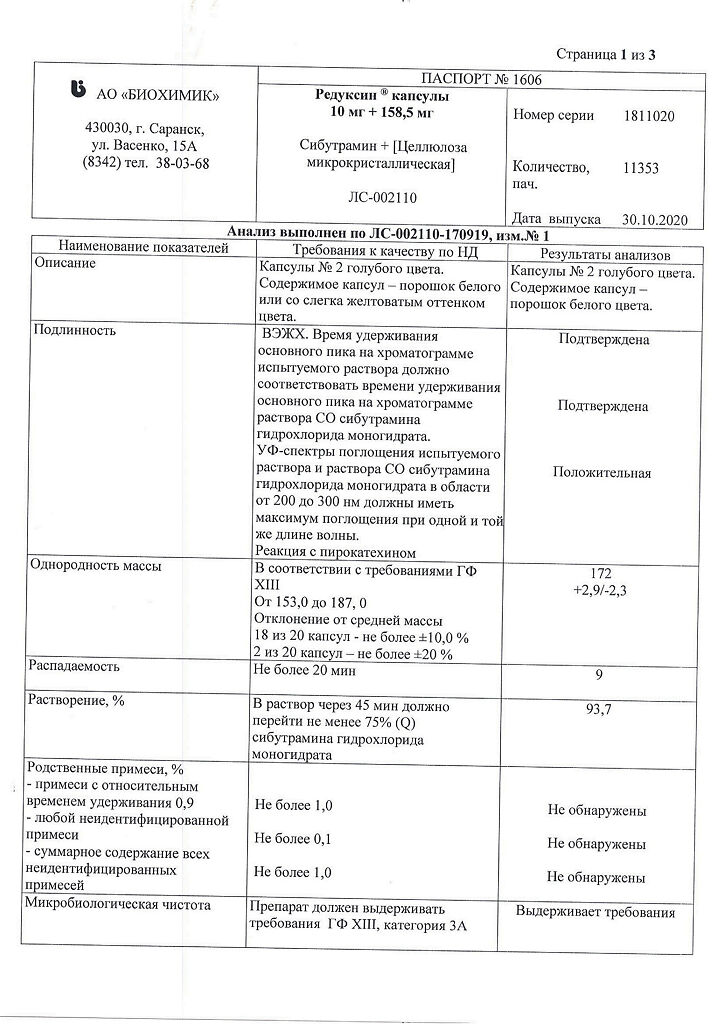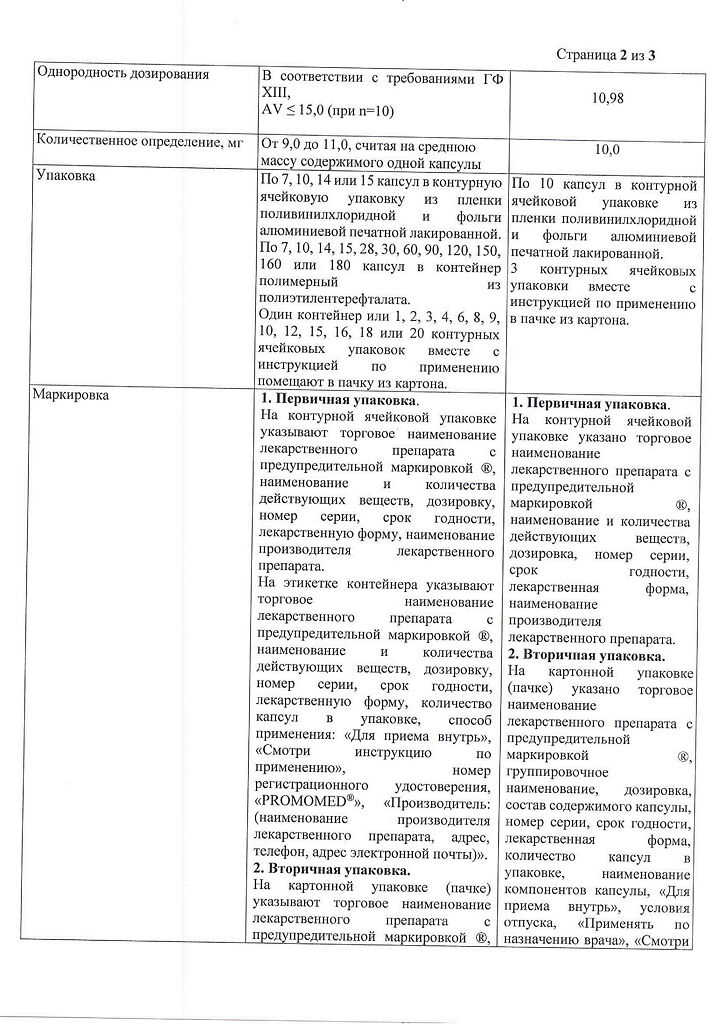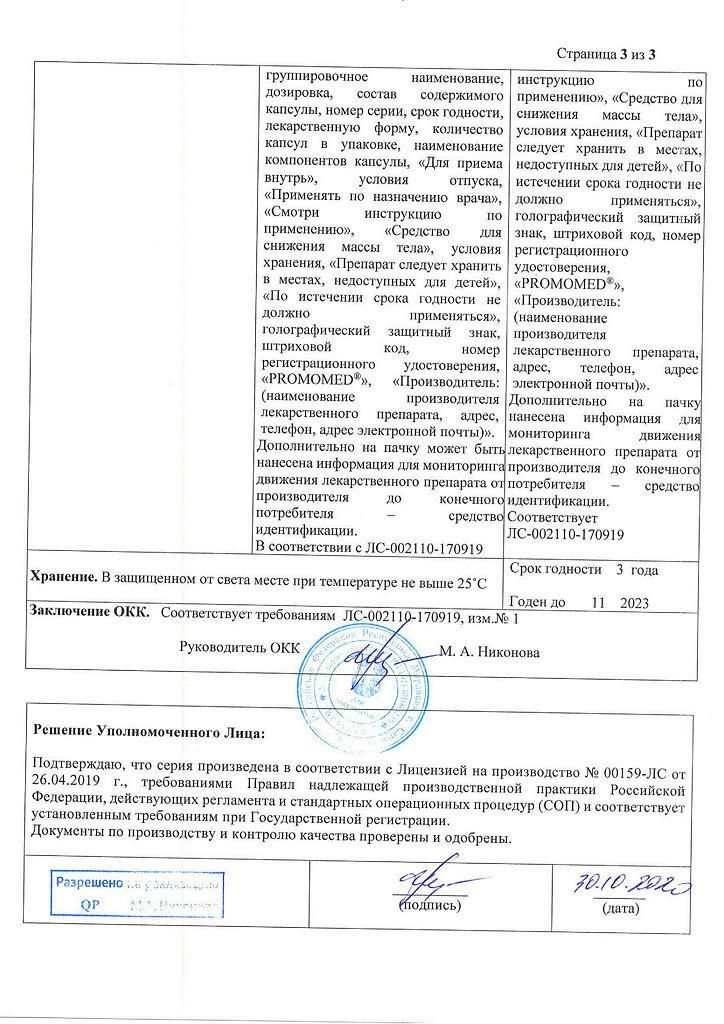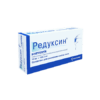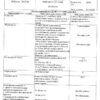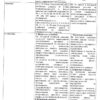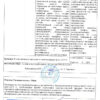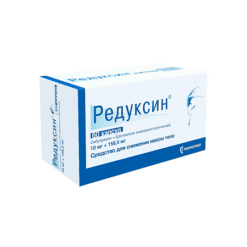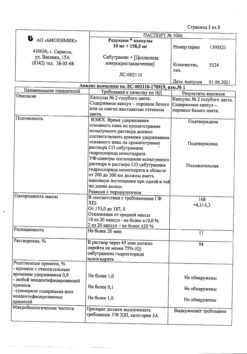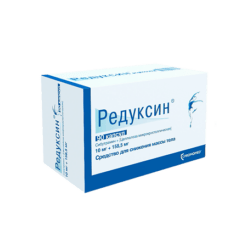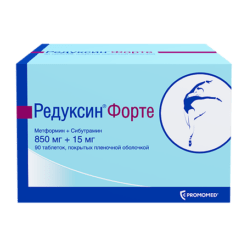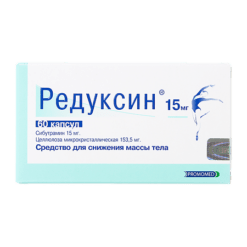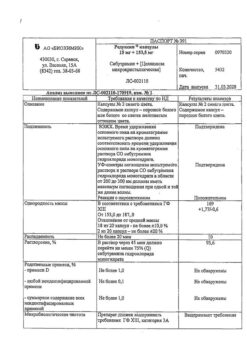No products in the cart.
Reduxin, 10 mg+158, 5 mg capsules 30 pcs
€68.73 €63.25
Description
A combined medication for the treatment of obesity, the action of which is due to its constituent components. Sibutramine is a prodrug and shows its action in vivo due to metabolites (primary and secondary amines) inhibiting monoamine reuptake (mainly serotonin and noradrenaline).
The increase of neurotransmitters in synapses increases the activity of central serotonin 5-HT receptors and adrenoreceptors, which contributes to an increased feeling of satiety and decreased need for food, as well as increased thermoreduction. By activating β3-adrenoceptors indirectly, sibutramine affects brown adipose tissue. Reduction of body weight is accompanied by an increase in the serum concentration of HDL and a decrease in triglycerides, total cholesterol, LDL, and uric acid.
Sibutramine and its metabolites do not affect the release of monoamines, do not inhibit MAO; have no affinity for a large number of neurotransmitter receptors, including serotonin receptors (5-HT1, 5-HT1A, 5-HT1B, 5-HT2A, 5-HT2C), adrenoreceptors (β1, β2, β3, α1, α2), dopamine (D1, D2), muscarinic, histamine (H1), benzodiazepine and NMDA receptors.
Microcrystalline cellulose is an enterosorbent, has sorption properties and non-specific detoxifying action. It binds and removes from the body various microorganisms, products of their vital functions, toxins of exogenous and endogenous nature, allergens, xenobiotics as well as excess of certain metabolic products and metabolites responsible for the development of endogenous toxicosis.
Pharmacokinetics
Absorption, distribution, metabolism
After oral administration of the drug sibutramine is rapidly absorbed from the GI tract, not less than 77%. It is subjected to the effect of “first passage” through the liver and is biotransformed with the participation of cytochrome P450 isoenzyme 3A4 to form two active metabolites (mono- and didesmethylsibutramine).
After a single dose of 15 mg, the Cmax of monodesmethylsibutramine is 4 ng/mL (3.2-4.8 ng/mL), that of didesmethylsibutramine is 6.4 ng/mL (5.6-7.2 ng/mL). Cmax of sibutramine is reached in 1.2 h, active metabolites – in 3-4 h. Administration simultaneously with food decreases Cmax of metabolites by 30% and increases the time of its achievement by 3 hours, without changing the AUC. It is rapidly distributed in the tissues. The binding of sibutramine to plasma proteins is 97%, and that of mono- and didesmethylsibutramine – 94%. Css of active metabolites in the blood is reached within 4 days after the start of treatment and is about 2 times higher than the plasma level after a single dose. </Excretion
T1/2 of sibutramine is 1.1 h, monodesmethylsibutramine 14 h, didesmethylsibutramine 16 h. Active metabolites undergo hydroxylation and conjugation to form inactive metabolites, which are eliminated mainly by the kidneys.
Indications
Indications
For weight loss in the following conditions:
— nutritional obesity with a body mass index (BMI) of 30 kg/m2 or more;
— nutritional obesity with a BMI of 27 kg/m2 or more in combination with other risk factors caused by excess body weight (type 2 diabetes mellitus/non-insulin dependent/or dyslipoproteinemia).
Pharmacological effect
Pharmacological effect
A combined drug for the treatment of obesity, the effect of which is determined by its constituent components. Sibutramine is a prodrug and exerts its effect in vivo through metabolites (primary and secondary amines) that inhibit the reuptake of monoamines (mainly serotonin and norepinephrine).
An increase in the content of neurotransmitters in synapses increases the activity of central serotonin 5-HT receptors and adrenoreceptors, which increases the feeling of satiety and reduces the need for food, as well as an increase in thermal production. By indirectly activating β3-adrenergic receptors, sibutramine acts on brown adipose tissue. A decrease in body weight is accompanied by an increase in the concentration of HDL in the blood serum and a decrease in the amount of triglycerides, total cholesterol, LDL, and uric acid.
Sibutramine and its metabolites do not affect the release of monoamines and do not inhibit MAO; do not have affinity for a large number of neurotransmitter receptors, including serotonin (5-HT1, 5-HT1A, 5-HT1B, 5-HT2A, 5-HT2C), adrenergic receptors (β1, β2, β3, α1, α2), dopamine (D1, D2), muscarinic, histamine (H1), benzodiazepine and NMDA receptors.
Microcrystalline cellulose is an enterosorbent, has sorption properties and a nonspecific detoxification effect. Binds and removes from the body various microorganisms, their metabolic products, toxins of exogenous and endogenous nature, allergens, xenobiotics, as well as an excess of certain metabolic products and metabolites responsible for the development of endogenous toxicosis.
Pharmacokinetics
Absorption, distribution, metabolism
After taking the drug orally, sibutramine is quickly absorbed from the gastrointestinal tract, by at least 77%. It is subject to the “first pass” effect through the liver and is biotransformed with the participation of the 3A4 isoenzyme of cytochrome P450 with the formation of two active metabolites (mono- and didesmethylsibutramine).
After taking a single dose of 15 mg, the Cmax of monodesmethylsibutramine is 4 ng/ml (3.2-4.8 ng/ml), didesmethylsibutramine – 6.4 ng/ml (5.6-7.2 ng/ml). The Cmax of sibutramine is achieved after 1.2 hours, of active metabolites – after 3-4 hours. Taking along with food reduces the Cmax of metabolites by 30% and increases the time to reach it by 3 hours, without changing the AUC. Quickly distributed into tissue. The binding of sibutramine to plasma proteins is 97%, and mono- and didesmethylsibutramine is 94%. Css of active metabolites in the blood is achieved within 4 days after the start of treatment and is approximately 2 times higher than the plasma level after taking a single dose.
Removal
T1/2 of sibutramine – 1.1 hours, monodesmethylsibutramine – 14 hours, didesmethylsibutramine – 16 hours. Active metabolites undergo hydroxylation and conjugation to form inactive metabolites, which are excreted mainly by the kidneys.
Special instructions
Special instructions
Reduxin® should be used only in cases where all non-drug measures for weight loss are ineffective – if the weight loss over 3 months is less than 5 kg.
Treatment with Reduxin should be carried out as part of complex therapy for weight loss under the supervision of a physician with practical experience in the treatment of obesity.
Complex therapy for obesity includes both changes in diet and lifestyle, as well as increased physical activity. An important component of therapy is the creation of prerequisites for permanent changes in eating habits and lifestyle, which are necessary to maintain the achieved weight loss even after drug therapy is discontinued. As part of therapy with Reduxin®, patients need to change their lifestyle and habits in such a way as to ensure that the achieved weight loss is maintained after completion of treatment. Patients should be clear that failure to comply with these requirements will lead to repeated weight gain and repeated visits to their doctor.
In patients taking Reduxin®, it is necessary to measure blood pressure and heart rate. During the first 2 months of treatment, these parameters should be monitored every 2 weeks and then monthly. In patients with arterial hypertension (whose blood pressure levels are above 145/90 mmHg during antihypertensive therapy), this control should be carried out especially carefully and, if necessary, at shorter intervals. In patients whose blood pressure exceeded 145/90 mmHg twice during repeated measurements. treatment with Reduxin® should be suspended.
The simultaneous administration of drugs that increase the QT interval requires special attention. These drugs include histamine H1 receptor blockers (astemizole, terfenadine); antiarrhythmic drugs that increase the QT interval (amiodarone, quinidine, flecainide, mexiletine, propafenone, sotalol); gastrointestinal motility stimulants (cisapride, pimozide, sertindole and tricyclic antidepressants). Caution should be exercised when using the drug against conditions that are risk factors for increasing the QT interval (hypokalemia, hypomagnesemia).
The interval between taking MAO inhibitors and Reduxin should be at least 2 weeks.
The connection between taking Reduxin and the development of primary pulmonary hypertension has not been established, however, given the well-known risk of drugs in this group, with regular medical monitoring it is necessary to pay special attention to symptoms such as progressive dyspnea (breathing difficulty), chest pain and swelling in the legs.
Impact on the ability to drive vehicles and operate machinery
Taking the drug Reduxin® may limit the patient’s ability to drive vehicles and operate machinery.
Active ingredient
Active ingredient
Sibutramine, microcrystalline cellulose
Composition
Composition
Active substances:
Sibutramine hydrochloride monohydrate – 10 mg
Microcrystalline cellulose – 158.5 mg
Excipients:
Calcium stearate – 1.5 mg
Capsule composition:
titanium dioxide – 2.0000%, azorubine dye – 0.0041%, brilliant blue dye – 0.0441%, gelatin – up to 100%.
Pregnancy
Pregnancy
The drug should not be used during pregnancy due to the lack of sufficiently convincing studies on the safety of the effects of sibutramine on the fetus.
Women of childbearing age should use contraception while taking Reduxin.
Reduxin® should not be used during breastfeeding.
Contraindications
Contraindications
– presence of organic causes of obesity (for example, hypothyroidism);
– serious eating disorders (anorexia nervosa or bulimia nervosa);
– mental illness;
— Gilles de la Tourette syndrome (generalized tics);
– simultaneous use of MAO inhibitors (for example, phentermine, fenfluramine, dexfenfluramine, ethylamphetamine, ephedrine) or their use within 2 weeks before prescribing Reduxin®; use of other drugs acting on the central nervous system (for example, antidepressants, antipsychotics); drugs prescribed for sleep disorders containing tryptophan, as well as other centrally acting drugs for weight loss;
— IHD, decompensated chronic heart failure, congenital heart defects, occlusive diseases of peripheral arteries, tachycardia, arrhythmias, cerebrovascular diseases (stroke, transient cerebrovascular accidents);
— uncontrolled arterial hypertension (BP above 145/90 mmHg);
– thyrotoxicosis;
– severe liver dysfunction;
– severe renal dysfunction;
– benign prostatic hyperplasia;
– pheochromocytoma;
– angle-closure glaucoma;
— established drug, drug or alcohol dependence;
– pregnancy;
– lactation (breastfeeding);
– children and adolescents up to 18 years of age;
— old age over 65 years;
– established hypersensitivity to sibutramine or other components of the drug.
The drug should be prescribed with caution in the following conditions: a history of arrhythmias, chronic circulatory failure, coronary artery disease (including a history), cholelithiasis, arterial hypertension (controlled and a history), neurological disorders, including mental retardation and convulsions (including a history), impaired liver and/or kidney function of mild to moderate severity, motor and verbal tics in anamnesis.
Side Effects
Side Effects
Side effects, depending on the effect on organs and organ systems, are presented in the following order (often – >10%, sometimes – 1-10%, rarely – <1%).
From the central nervous system and peripheral nervous system: often – dry mouth, insomnia; sometimes – headache, dizziness, anxiety, paresthesia, and changes in taste; in isolated cases – back pain, depression, drowsiness, emotional lability, anxiety, irritability, nervousness, convulsions.
One patient with schizoaffective disorder, which was presumed to exist before treatment, developed acute psychosis after treatment.
From the cardiovascular system: sometimes – tachycardia, palpitations, increased blood pressure, vasodilation. There is a moderate increase in blood pressure at rest by 1-3 mm Hg. and a moderate increase in heart rate of 3-7 beats per minute. In some cases, more pronounced increases in blood pressure and heart rate cannot be ruled out. Clinically significant changes in blood pressure and pulse levels are recorded mainly at the beginning of treatment (in the first 4-8 weeks).
From the digestive system: often – loss of appetite, constipation; sometimes – nausea, exacerbation of hemorrhoids. If you are prone to constipation in the first days, monitoring the evacuation function of the intestines is necessary. If constipation occurs, stop taking it and take a laxative. In isolated cases, abdominal pain, paradoxical increase in appetite, transient increase in the activity of liver enzymes.
Dermatological reactions: sometimes – sweating; in isolated cases – skin itching, Henoch-Schönlein purpura (bleeding into the skin).
From the body as a whole: in isolated cases the following undesirable clinically significant phenomena have been described: dysmenorrhea, edema, influenza-like syndrome, thirst, rhinitis, acute interstitial nephritis, bleeding, thrombocytopenia.
Withdrawal reactions such as headache or increased appetite are rare. There is no evidence that withdrawal symptoms, withdrawal symptoms or mood disturbances occur after treatment.
Most often, side effects occur at the beginning of treatment (in the first 4 weeks). Their severity and frequency weaken over time. Side effects are generally mild and reversible.
Overdose
Overdose
There are extremely limited data on sibutramine overdose. In case of overdose, the patient should consult a doctor.
Symptoms: possible increased severity of side effects. Specific signs of overdose are unknown.
Treatment: taking activated charcoal, gastric lavage, symptomatic therapy, with increased blood pressure and tachycardia – prescribing beta-blockers. There is no special treatment or specific antidotes. It is necessary to carry out general measures: ensure free breathing, monitor the state of the cardiovascular system, and, if necessary, carry out supportive symptomatic therapy. The effectiveness of forced diuresis or hemodialysis has not been established.
Storage conditions
Storage conditions
In a place protected from light, at a temperature not exceeding 25 °C
Shelf life
Shelf life
3 years
Manufacturer
Manufacturer
Biokhimik JSC, Russia
Additional information
| Shelf life | 3 years |
|---|---|
| Conditions of storage | In a light-protected place, at a temperature not exceeding 25 °C |
| Manufacturer | Biokhimik JSC, Russia |
| Medication form | capsules |
| Brand | Biokhimik JSC |
Other forms…
Related products
Buy Reduxin, 10 mg+158, 5 mg capsules 30 pcs with delivery to USA, UK, Europe and over 120 other countries.


